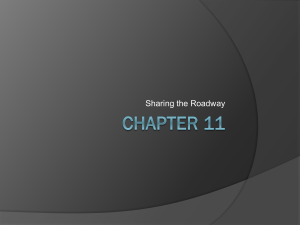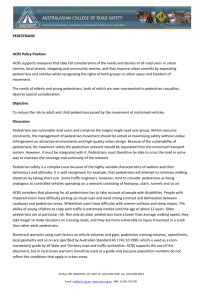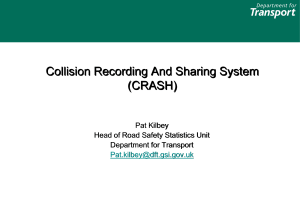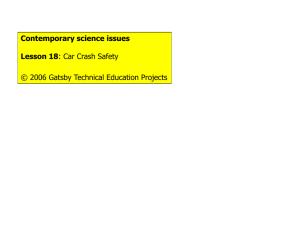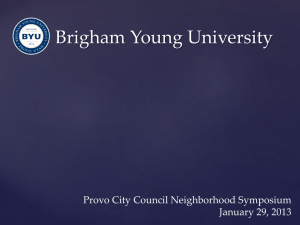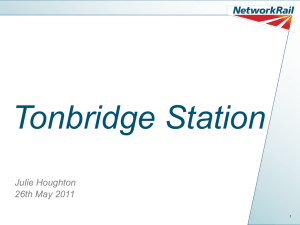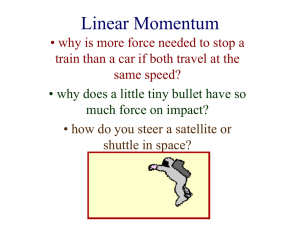presentation
advertisement
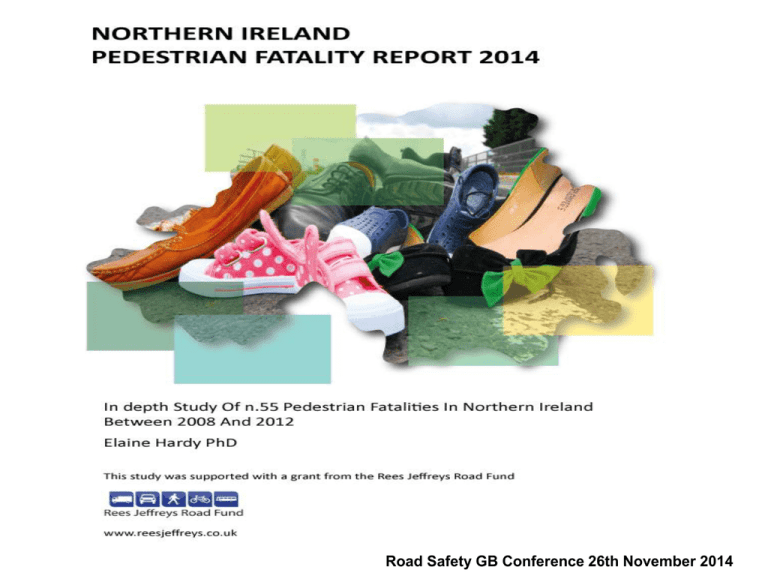
Road Safety GB Conference 26th November 2014 Northern Ireland Pedestrian Fatality Report 2014 The report analyses No. 55 cases carried out by eight investigators from the Forensic Science Northern Ireland Road Traffic Collision Investigation Unit. These (55 fatalities) equal 73% of the total pedestrian fatalities in Northern Ireland (n.75) between 2008 and 2012. There was additional information from 37 case files provided by the Coroners’ Service Northern Ireland. Road Safety GB Conference 26th November 2014 2 Pedestrian Fatalities 2008 - 2012 24 19 14 13 13 10 2008 10 10 2009 2010 pedestrians killed Road Safety GB Conference 26th November 2014 9 2011 8 2012 FSNI 3 Methodology • The n.55 collision scenes were attended by an FSNI investigator, a PSNI photographer and mapper. • The files that the investigators prepare include photographs of the collision scene, witness statements, maps, diagrams, laboratory examinations and their findings which are compiled in a report from each collision investigation. • Typically, the investigator arrives at the collision scene within 2 to 4 hours following the collision. Each collision investigation takes approximately six months to complete. Road Safety GB Conference 26th November 2014 4 Methodology cont.... Vehicle data • Vehicle registration number, manufacturer, model • Mechanical factors data • Contribution of design or maintenance defects to collision or injury causation • Collision or injury related cause factors • Vehicle speed • Vehicle systems: brakes, suspension, lighting Collision scene, environment • Road Topography • Collision scene data • Traffic and controls • Verify collision configuration • Preview collision cause factors • Collision contribution of weather, view obstructions • Collision contribution of road conditions and defects Pedestrian factors • Pre collision movements • Orientation of pedestrian on impact • Position of pedestrian on impact • Rest position • Clothing Road Safety GB Conference 26th November 2014 5 Vehicles involved There were n.35 (64%) cars involved in collisions with pedestrians, n.8 (15%) lorries, n.5 (9%) vans, n.3 (5%) buses and n.3 (5%) taxis. There was one trailer involved in a collision with a pedestrian. 5% 2% 9% 5% 15% 64% bus Road Safety GB Conference 26th November 2014 car lorry taxi trailer van 6 Speed In n.50 (91%) of the incidents, the vehicle was not driven at excessive speed. The five drivers who exceeded the speed limit all did so where the maximum speed limit was 30 mph and on an urban road and in all five cases the vehicles involved were cars. The calculations of the speed of those vehicles refer to the absolute minimum speed that the investigator was able to calculate based on the evidence available, although the range of speed may have increased the actual speed to a much higher level. Road Safety GB Conference 26th November 2014 7 Collision Scene Environment Time n.13 collisions (23.6%) occurred from 10 p.m. up to 6 a.m. while n.16 (29.1%) occurred between 6 a.m. to 3 p.m.; n.13 (23.6%) occurred from 3 p.m. to 7 p.m. and the remaining n.13 (23.6%) occurred between 7 p.m. and 10 p.m. Season There were n.17 (31%) pedestrian fatalities in spring; n.15 (27%) in winter; n.12 (22%) in autumn and n.11 (20%) in summer. Weather In n.22 (40%) collisions, the weather was dry; in n.11 (20%) collisions, there was either heavy rain or rain; in a further n.11 (20%) cases, the conditions were indicated as wet; in one case (2%) it was foggy and in another it was a sunny day (2%). In n.9 cases (16%) there was no indication of the weather conditions. Location The majority of the collisions (n.34 or 62%) occurred on an urban road, while n.20 (36%) occurred on a rural road and one case (2%) occurred on a motorway. (Road conditions were indicated as good in 53 cases and fair in two cases). Road Safety GB Conference 26th November 2014 8 Visibility Visibility conditions when the collision occurred 36% 64% darkness Shade of clothing worn by pedestrian 30 22 3 not indicated Road Safety GB Conference 26th November 2014 dark light 9 Orientation Of the cases where the orientation was identified, (n.44/55) indicates that n.8/30 pedestrians were struck from behind in darkness, n.4/30 in front and n.18/30 on the side. During daylight, all cases where the orientation was identified (n.14) were struck on the side. ...Cont Lighting During the period of darkness, there was information in relation to n.31/35 cases. In the n.14 cases where there were street lights, n.13 cases were on urban roads and in one case there were street lights on a rural road. Of the n.17 cases where there was no street lighting in a period of darkness, n.16 fatalities took place on rural roads, and one on a motorway. Glare There were n.13 (23.6%) cases in which glare was a contributory factor in the collisions with the pedestrians. With the exception of n.2 cases, these collisions occurred during the hours of darkness and the glare came from the headlights of oncoming vehicles which meant that the driver was distracted. In the two cases that occurred during daylight, the glare came from the sun which was low in the sky and drivers were unable to discern the pedestrians. Road Safety GB Conference 26th November 2014 10 Pedestrians involved: children Seven children aged between one to 16 years represented the smallest group (12.7%) These seven pedestrians aged between one and 16 include three toddlers (aged less than three years) and one slightly older child. Three of these children were in the care of an adult relative (not parent) the remaining child was in the company of an older sibling when the collision occurred. There was a teenage male going to school in the morning on an urban road, he walked in front of a car as his view was obstructed by another car; another teenage male pedestrian was struck from behind while walking on a rural road late at night with a friend. At the time, he was wearing dark clothes and had his back to the oncoming car; a teenage female walked in front of a bus while holding an umbrella which blocked her view of the bus. In all the above cases the vehicles were reported as not having exceeded the maximum speed limit. NB: over the period 2008 to 2012, n.10 pedestrians up to the age of 16 were killed in Northern Ireland Road Safety GB Conference 26th November 2014 11 Pedestrians involved: Elderly There were n.17/55 (31%) elderly pedestrians (aged over 70 years) involved in collisions with vehicles. n.8/17 were aged between 80 and 100 (the age of two of the pedestrians was only indicated as “elderly”). The remaining n.7 were aged between 70 and 79 years. Four of those aged 80 and over were in the path of the vehicle on the road. Overall, n.13/17 elderly pedestrians were struck between 7 a.m. and 6 p.m. In n.5 cases, the elderly pedestrians (n.2 females and n.3 males) crossed the road in front of a lorry. There were n.4 cases where the car driver was unable to discern the pedestrian due to either glare from the lights of oncoming vehicles or (in n.2 cases) glare from the sun. In two cases the vehicle reversed into the elderly pedestrians. Both were reversing at a very low speed. Road Safety GB Conference 26th November 2014 12 Pedestrians involved: Intoxicated NB: The information from the Pathologists’ reports was provided with the Coroners’ inquest findings for n.17/55 pedestrians (31%) who were found to have alcohol in their blood at the time of the collision. The average Blood Alcohol Content for these n.17 pedestrians was 232 mg per 100 ml. Road Safety GB Conference 26th November 2014 13 “Other” Collisions There were 9 other collisions in which 8 pedestrians were struck by cars and one was struck by a van. The age of these pedestrians ranged from 18 years to 62 years. Of the six cases which occurred in darkness, only one pedestrian was wearing reflective clothing, the remaining five were wearing dark clothing with no reflective elements. In all these cases the vehicles were reported as not having exceeded the speed limit. In four cases the pedestrian crossed the road in front of the vehicle and the driver was unable to stop in time to avoid the collision. Overall there were four cases where the driver was distracted by the glare of lights from oncoming traffic which may have affected his/her ability to stop in time to avoid the collision. In one case the pedestrian was walking her dog on a rural road in the same direction of the car which subsequently struck her from behind. She was wearing dark clothing and there were no street lights. In the case where the driver had a heart attack and lost consciousness, the pedestrian was walking on the footpath and the car careered off the road and hit the pedestrian before hitting a wall. Road Safety GB Conference 26th November 2014 14 Cognitive Impairment Driver visibility, elderly and intoxicated pedestrians have a common theme which is that for different reasons there are problems of cognitive impairment. From the research , evidence indicates that vehicle drivers are restricted at night time or in darkness, because their vision is impaired due to problems which are exacerbated by the lack of ambient illumination, the limited power and aim of headlights, the conflict between positive and negative contrast and by night myopia and glare. Elderly pedestrians experience cognitive and executive function decline as they age, and functional limitations are most prevalent towards the end of normal life. Finally intoxicated pedestrians suffer cognitive impairment because alcohol slows brain functions, reduces judgement, increases risk taking, affects sense of balance and increases sleepiness. Alcohol reduces the ability to judge the speed and distance of vehicles. Road Safety GB Conference 26th November 2014 15 Thank you! http://www.righttoride.org.uk/ni-pedestrian-fatality-report-2014/ With gratitude to the Forensic Science Northern Ireland Road Traffic Investigation Team and the Coroner's Service Northern Ireland for allowing access to the case files from which this report is based. Road Safety GB Conference 26th November 2014 16
